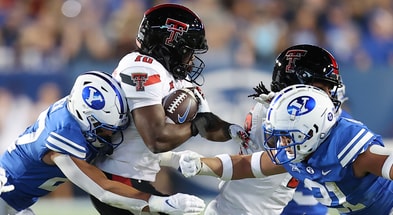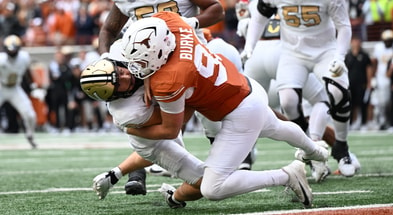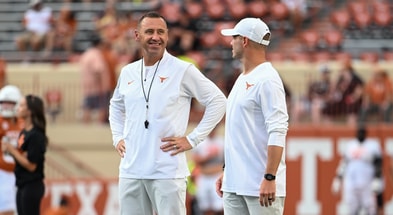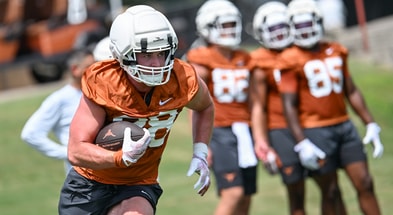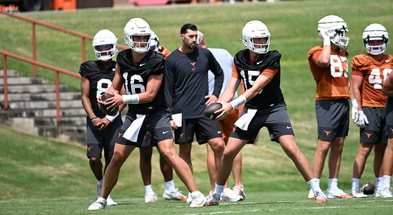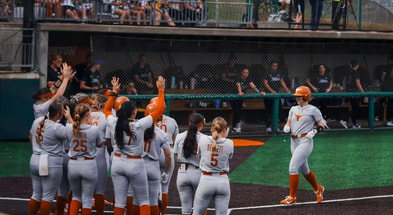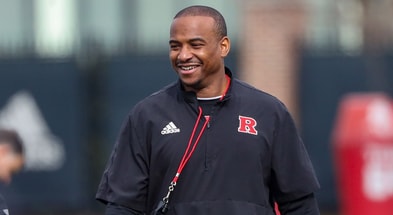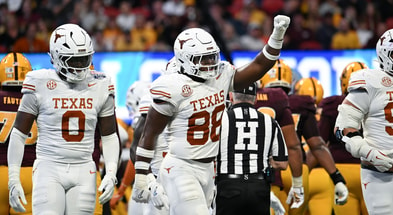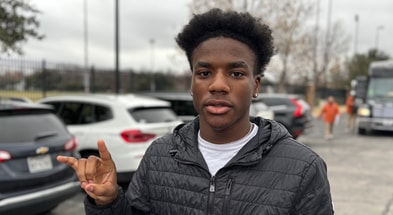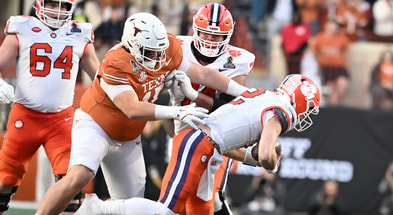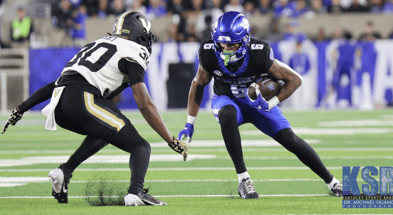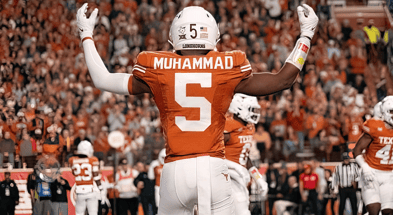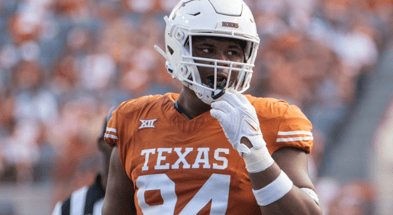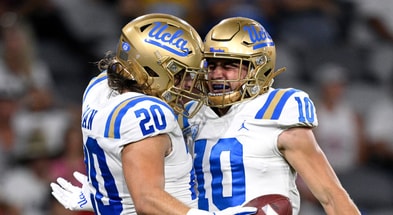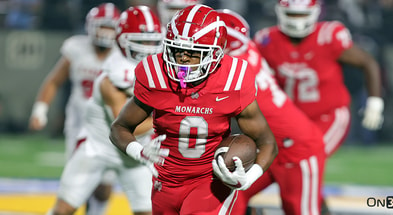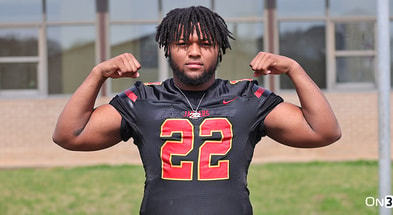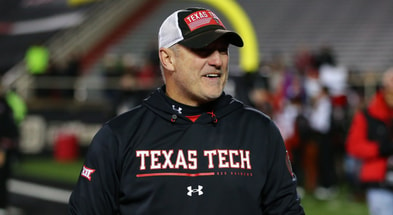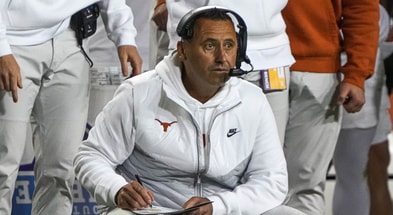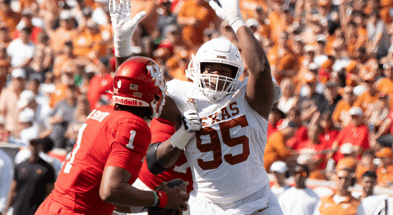Inside the Gameplan: Beneficiaries of the new offense

UT’s changes to its offense has already had a ripple effect across the entire program without the Longhorns doing anything other than lining up in more spread formations in their spring scrimmage.
Old coaches have departed, new ones have been brought aboard, and the program is suddenly surging in recruiting in-state QBs and WRs.
When you choose to re-adopt the offense that generated the program’s first championship in over 30 years, there is going to be a great deal of buzz.
Strong has repeated over and over again that the main aim for moving to the offense was to tap into what’s already happening in the state. The large majority of Texas high school programs are running spread systems and by the time the best skill players and quarterbacks reach college, they are already familiarized with some of the main practices and tactics that are standard across most of the spread systems.
The benefits here can be seen in history from the Nebraska Cornhuskers program under Tom Osborne. Much of the state of Nebraska was dialed into what Osborne’s Cornhuskers were doing and running some of his system at the high school and middle school levels.
If you consider how many of the top high school programs in Texas max out their players by emphasizing the same system from middle school through varsity, you can get a sense of how much simpler it is for a college team to be able to build on what high school players are already learning rather than tearing them down and rebuilding them in a new image.
Take new 2017 UT QB commit Sam Ehlinger, for instance. The new local hero is learning a spread system from a coach with connections to the Texas staff and is also essentially receiving extra coaching from Watson in his free time. Even if Watson is unable to keep his job, the benefits of all that coaching and development for both Ehlinger and Texas will be considerable.
This leads us to what really matters for Strong and his staff, that this system benefits the right players on the Texas roster so that they can win games. In addition to unlocking the state’s best offensive players, there can be little doubt that the move to the spread was also intended to help the players already on campus who grew up playing these schemes and are likely to produce their best within that system.
If you are the flagship program of the state, it makes sense to try and tap into what makes that state strong.
Here are the 5 players that will benefit most from Strong’s move to the spread.
Tyrone Swoopes
Swoopes’ demonstrated a few things very clearly in 2014. He has a cannon arm that can do work when he has simple reads and can get the ball out quickly, he’s an absolute bull when he’s allowed to get downhill quickly running the football, he struggles to navigate throws and reads in the middle of the field, and he’s prone to freezing up and making very costly mistakes when dealing with disguise and pressure.
As I’ve said before, the best fit for Swoopes would be the Baylor system in which many of the throws are outside the hash marks and defenses are spread wide so that they struggle to pack players in the middle or disguise their looks. However, Texas’ new spread looks should also prove very helpful to Swoopes as he looks to rebound in 2015.
The offense that Texas rolled out in the spring game was heavy on perimeter screens and quick passes paired with the run game, concepts that Swoopes thrived with a year ago and very nearly led to victories against UCLA and Oklahoma.
The more that Watson can spread out opposing defenses, the simpler the reads become for Swoopes and the more difficult it becomes for opponents to handle either his arm strength or his size and power.
Favorite new scheme
One of the defenses that Texas will have to be ready to attack in 2015 will be this variety of cover 4 that uses the boundary safety and nickel to outnumber the run game while leaving the corners and free safety deep. With Swoopes’ arm strength and sheer power, Watson can get after the numerous teams that use this scheme with a combination of the “spot” passing concept and the QB draw:
Everyone talks about how Heard could make a move against Swoopes when the pads come on but they forget how dangerous Swoopes could be on plays like this when his opponents have to actually bring him to the ground while he’s lowering his helmet and plowing forward.
For this concept, the running back runs wide and Swoopes can read the middle linebacker to see if he widens out to help cover or stays in the box. If it’s the former, Tyrone can plunge upfield behind the double team and lead block by his H-back. If it’s the latter, the defense will get stretched out trying to cover this triangle read and Swoopes can pick them apart with laser throws to the perimeter.
Texas had success with this passing play in 2015, if they’re willing to frequently mix in the QB run game with it they could have something special.
Jerrod Heard
A two-time state champion as a result of running the ball in spread schemes, Heard is an obvious beneficiary of the new system. Where Jerrod could really shine is if Texas will mix in some QB run schemes that don’t have passes attached and allow Heard to just do what he does best and run wild on opponents.
Besides having the chance to run the same zone and power read plays that he used to dominate high school opponents, the Texas spread gives Heard some chances to use his legs to attack space and put defenders in conflict.
Favorite new scheme
An example would be this field rollout play that Heard utilized in the spring game to great effect:
Whereas Swoopes usually relies on his arm strength to hit targets outside the hash marks, Heard likes to explore the space on the field and roll towards his reads. In the spring game, Texas would often send a fullback or running back with him to cut block the defenders responsible for running at Heard to force him to make a throw and prevent him from just taking off with the scramble.
The remaining defenders are then in quite the bind. Do they close on Heard to stop him from running through them or do they stay with their assigned receivers in coverage? Heard demonstrated the ability to punish hesitation here by throwing some accurate balls on the run rolling in either direction.
It’s like a classic RPO, and the spacing created by a spread formation makes it harder for opponents to handle.
Johnathan Gray
Gray has always been better in running schemes that allow him to slash and cut and make use of space. He’ll probably be the main beneficiary in Texas’ move away from the double TE formations that often simply served to invite defenses to load the box without much fear that Texas could make them pay with the vertical passing game with only two receivers (neither of whom were particularly scary deep threats) on the field.
Favorite new scheme
The sprint-out draw that Texas combined with the rollout passing game is ideal for Gray since it gets defenders flowing in one direction to stop a Swoopes/Heard scramble or rollout and then forces them to try and change directions in time to catch Gray.
Top 10
- 1New
ESPN Top 25
Big moves after Week 11
- 2Trending
College Football Playoff
Predicting 12-team bracket
- 3Hot
AP Poll Prediction
Top 10 shakeup coming
- 4
Fernando Mendoza
QB delivers Heisman moment
- 5
Garrett Nussmeier
LSU benches QB
Get the Daily On3 Newsletter in your inbox every morning
By clicking "Subscribe to Newsletter", I agree to On3's Privacy Notice, Terms, and use of my personal information described therein.
Gray’s specialty is making really hard cuts in space that leave defenders frozen in time, if you combine his runs with schemes that threaten the perimeter with Heard getting outside of contain, you create major headaches for defensive coordinators.
Whoever wins the battle at slot receiver
Daje Johnson, Jacorey Warrick, Armanti Foreman, Marcus Johnson, it’s not totally clear who will take most of the snaps at inside receiver. However, the spread is going to mean more snaps are available for this position and a variety of skill sets are going to be utilized.
The Watson passing game should thrive with the introduction of another receiver at H or Y rather than a stiffer option with poor hands like Geoff Swaim. Speedsters like Daje Johnson or Roderick Bernard could also thrive as the spread option concepts make it possible for them to get the ball in space without having to learn how to run timing routes or have great hands.
Hopefully Texas can balance these benefits without tipping its hand to opponents on what to expect from a given personnel package. What’s most likely is that the more versatile players like Warrick and Foreman, who can combine explosive speed with route-running ability, will just see the ways in which they can get the ball increase.
With any schematic shift, there will always be losers in addition to winners. Guys that will now have to do dirty work they avoided in the past, players that now have demanding responsibilities, and athletes who are no longer going to be in their own ideal context.
The spread offense can generally be made to work for a wide variety of different talents since its only real ethos is to use spacing to attack opponents, however there are players that don’t thrive in space.
Marcus Hutchins and Connor Williams
The No. 1 challenge for every spread offense is how to handle defensive ends and how to handle the blitz. Some systems call for getting the ball out quickly, some will make it a point to leave the ends unblocked and read them on the option, and many will throw tons of screens to punish aggressive teams.
Nevertheless, in spite of all these tactics responsibility will inevitably fall on the offensive tackles to control explosive defenders without getting consistent help from an ancillary like a tight end.
The Big 12 is unusually loaded at edge rusher in 2015 with OSU’s Emmanuel Ogbah, OU’s Eric Striker, Tech’s Pete Robertson, Baylor’s Shawn Oakman all lurking on the schedule along with some other players that are undoubtedly going to break out next season.
Against this murderer’s row, Texas has 6-foot-3, 280-pound converted defensive tackle Marcus Hutchins and true freshman Connor Williams. Additionally, the Texas interior wasn’t exactly rock solid at handling blitzes and stunts last year so they often need pass protection assistance as well.
Where do you send help if you are the Texas staff looking to give the QB time to make a read and throw it downfield? It should be relatively simple for opponents to scheme pressure against Texas on passing downs in 2015 and if the Longhorns can’t run the ball and stay ahead of the chains, this issue could rear up again in a major way with the new scheme.
Andrew Beck and Blake Whiteley
The tight ends may also be losers in the new scheme, but what’s most probable is that they’ll spend much of their time as ancillary blockers or on the bench so that more slot receivers can get on the field.
Texas will obviously need to use six-or seven-man protections at times to protect the quarterbacks and Watson will also be looking for escorts for the more explosive players on perimeter screens, lead runs, and rollouts. The tight ends will inevitably draw these assignments and their focus here will likely result in slot receivers getting the more glorious assignments to run wheel routes or stretch the seams simply because they’ll be spending more practice time mastering those skills.
So tight ends will be important in the new system, but they probably won’t be particularly glorious in purpose, they’ll basically be mobile blocking surfaces.
As we’ve discussed before, Swoopes and Heard have different strengths and weaknesses and it’s very much in the staff’s interest to pick one early in the fall so the team can build an identity around the specific strengths of the winner. No matter who that is though, the new scheme is going to mean that there’s an additional burden carried this season by the offensive line and tight ends.
Let’s all hope that the identity is sorted out quickly and that the OL and young prospects are ready to take a big step forward in holding up their end of the deal. Otherwise we’ll have to wait till 2016 to really see the main positive results of the needed schematic shift.








